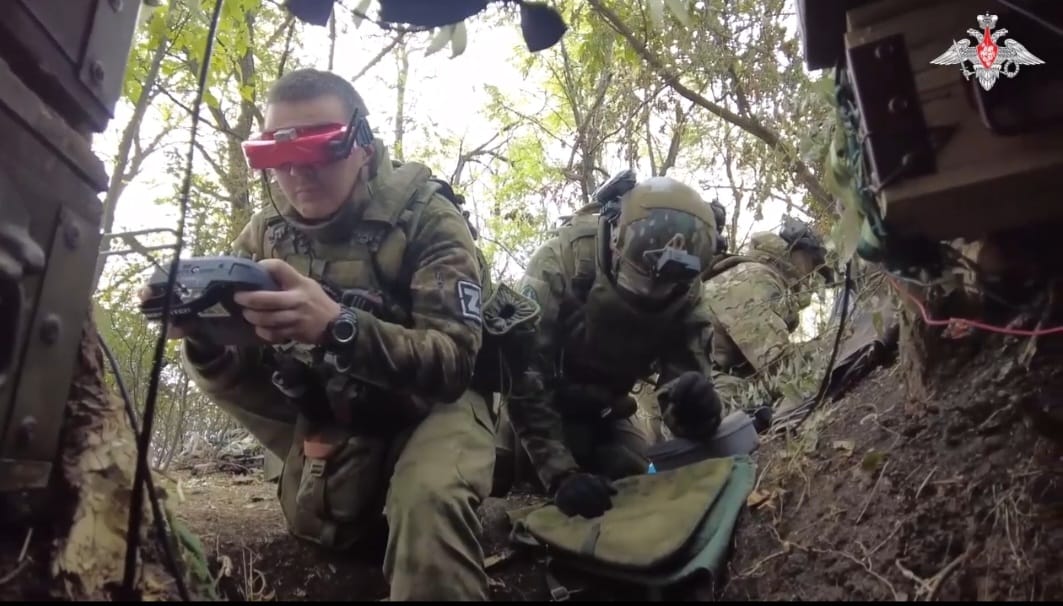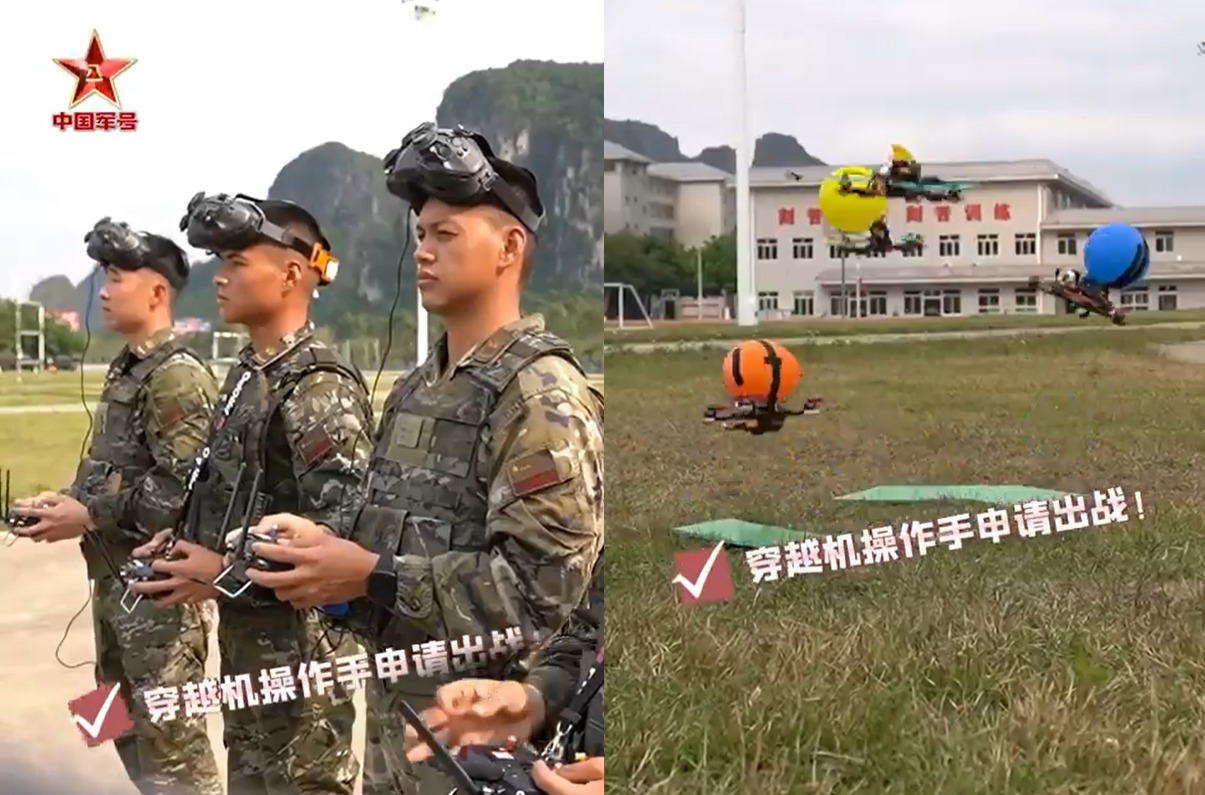Footage has emerged from China showing People’s Liberation Army (PLA) soldiers flying small First-Person View (FPV) UAVs through complex obstacles.
This follows the emergence of FPV loitering munitions used by the Russian and Ukrainian armies for attacking a group of soldiers or a lone combatant.
Segments of the clips from Chinese state media indicate PLA planners have recognized how small drones have upturned certain established battlefield principles and are possibly moving towards incorporating the drones at the small infantry unit level.
Having established their efficacy in Gaza as well, where Hamas initially caused many casualties among the Israeli Defense Forces (IDF), they threaten to be a major disruptor before tactical Indian Army operations.
Chinese Attack FPV UAV Pilots
One clip posted by drone and PLA watcher Jesus Roman showed People’s Armed Police (PAP) FPV UAV operators “practicing acrobatic and kinetic targeting flights.”
Roman noted the exercises’ inspiration from Ukraine. “Again similar TTPs than in Ukraine, although the PAP in particular, has been already practicing these techniques for years.” (TTP is an abbreviation for Tactics-Training-Procedures).
🇨🇳People's Armed Police (PAP) FPV UAV operators with VR googles practicing acrobatic and kinetic targeting flights.
Again similar TTPs than in 🇺🇦Ukraine, although the PAP in particular, has been already practicing these techniques for years (via wb/沉默的山羊) pic.twitter.com/UfNQAFBLRW
— Jesus Roman (@jesusfroman) March 15, 2024
Another clip, posted by PAP Propaganda Bureau member Zhao DaShuai, showed a PLA soldier with VR goggles releasing an FPV UAV. The view from the drone camera shows it deftly going through bunkers and openings. Secondary footage captured other drones striking static armored targets – mostly decommissioned tanks.
🇨🇳People's Armed Police (PAP) FPV UAV operators with VR googles practicing acrobatic and kinetic targeting flights.
Again similar TTPs than in 🇺🇦Ukraine, although the PAP in particular, has been already practicing these techniques for years (via wb/沉默的山羊) pic.twitter.com/UfNQAFBLRW
— Jesus Roman (@jesusfroman) March 15, 2024
There is little doubt about the reliability of the video showing damage to the tank and the efficacy of attack FPV UAVs. This is because dozens of official and unofficial videos released by both the Russian and Ukrainian armies show such drones successfully destroying many of each other’s tanks.
Drone Piloting Is The New Military Specialization
The war in Ukraine saw UAV usage evolving from strapping simple drones with explosives to fly into enemy armor to multiple or single First-Person View (FPV) drones targeting individual enemy soldiers holed in bunkers, trenches, and hideouts.
Ukraine saw drones become a substitute for artillery owing to the shortage of howitzer rounds, and FPV kamikaze evolved into anti-infantry weapons, redefining classic gun battles.
That such drones can be cheap systems with off-the-shelf drone motors and electronics means they can be mass manufactured and overwhelm electronic warfare (EW) systems – since a jammer cannot disable a swarm of over a dozen small warhead-armed FPV UAVs – poses another challenge.
Drone piloting thus spawned into a new military vocation, with both the Russian and Ukrainian militaries offering specialized courses for the full breadth of small UAV piloting.
This ranged from FPV drone flying, elementary electrical and electronic engineering for drone maintenance and repairs, drone software and firmware coding, warhead assembly, and basic battlefield infantry tactics and physical training.
China's PLA have fully embraced FPV suicide drones. pic.twitter.com/IzLeYykkDH
— Zhao DaShuai 无条件爱国🇨🇳 (@zhao_dashuai) March 16, 2024
Russia even integrated this ‘skills development’ endeavor at a national level with its ongoing push to develop its domestic drone, technology, and electronics sector to make up for its historical lag in the area. It has consistently held drone race competitions, UAV development contests, and hackathons among its engineering colleges and academia.
Videos from such events show small drones maneuvering intricate man-made obstacles to reach hard-to-access waypoints within set time limits. China’s rapid adoption of the FPV drones among its ground troops stems from this lesson in the war.
Battlefield Utility
These drones can be immensely useful in all types of terrain and battlefield scenarios, able to target everything from tanks, armored vehicles, bunkers, built-up structures, and even large systems like ground-based air defense missiles and radars.
Taking a massive load off the individual soldier, they offer a mutually supportive role in destroying light yet sticky targets that cannot be quickly prosecuted owing to the limits of human endurance or the elements.
A suitable example can be urban warfare, where the prevailing wisdom about its characteristics largely remains true – that it favors the defender and imposes massive costs on the attacker. Any victory, therefore, would be painful and come with unacceptably high casualties as the defender exploits the debris in a built-up environment to sow confusion and disarray.
But FPV drones can fly into the tight crevices, nooks, and rubble of collapsed buildings, from where a defending army is grinding down an enemy assault to detect and destroy such hidden posts. Taking down such targets quickly, which would otherwise require several dozen soldiers and attempts, maintains an attacker’s operational tempo.

Likewise, such hidden fortified positions like machine guns or mortar nests stalling an enemy attack in the mountains, plains, or jungles can be harassed – if not hit – by fast-flying FPV UAVs. Manned teams can quickly capture such positions in a matter of a few minutes instead of hours or even days and force rapid retreats.
They can also hit tanks and armor – as seen in the clip on X – and unburden their own anti-tank guided missile (ATGM), tank, artillery, or Z-10 attack helicopters from smaller engagements.
FPV War At An Industrial Scale
At a larger logistical level, it also spares pressing in bigger platforms like artillery, Unmanned Combat Aerial Vehicles (UCAV), or attack helicopters that can fully focus on large strategic targets. The complete availability of these bigger capital weapons, with little to no absence from the battlefield, lends an undeniable advantage.
China, with its predominance in electrical, electronic, and mechanical goods manufacturing and exports, is in a far better position than Russia to produce hundreds and thousands of such drones for PLA ground troops.
Such an industrial capacity also allows it to swiftly introduce improved versions of the drones following feedback from troops—a process that might be well underway. Before India in Ladakh, FPV kamikaze drones could have a considerable impact at the ‘small unit’ tactical level in infantry-on-infantry clashes.

Solutions for India
India has already seen an explosion of drone and technology company start-ups that can be roped in to develop and mass-manufacture portable anti-drone systems. Russia has armed a significant number of its units with various versions of its Stupor hand-held anti-drone gun, with soldiers often recorded aiming at, jamming, and bringing down Ukrainian UAVs.
DRDO labs like the Electronics Research Development Establishment (LRDE) can develop such portable weapons by studying the electronic warfare (EW) and drone technology thrown up in the Ukraine war from open source literature. This can either be done singularly or through joint collaboration with drone startups or academia.
With full transfer of technology (ToT), such systems can be mass-manufactured and rapidly allocated to forward Indian infantry units. Lastly, as mentioned before, such attack FPV UAVs are not technologically complex platforms and can be made with basic components.
The DRDO and Indian drone companies can quickly develop a basic design and field a working prototype, while the Indian Army can acquire it under the Indigenously Designed, Developed, and Manufactured (IDDM) category for rapid induction.
It might be technologically inferior to the PLA’s drones, but having something in mass is better than having nothing of it at all.
- The author can be reached at satamp@gmail.com
- Follow EurAsian Times on Google News




